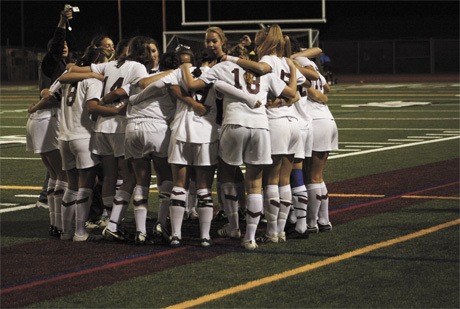The City Council and school district are once again butting heads over Islander Stadium. The stadium, which is used by both school and public sports teams, has been the source of argument on and off since the two parties agreed to share the amenity in 2003.
Today, nearly two months after the school district purchased a new turf field (the former turf was deemed unsafe for use last summer despite the fact that it had more than a year left on its warranty), both sides are deliberating over the conditions of a new interlocal use and operation agreement.
Approval of the document was stalled last Monday when City Council members noticed a school-district proposed stipulation under “Procedures for Managing Stadium Use.” According to the document, the stadium will from now on be “secured at all times.” Keys or “other means of access,” which include the possibility of electronic entry cards, will be issued for approved stadium activities. It is the district’s responsibility to issue these keys to members of the public who wish to use the stadium.
Four sets of keys will also be given to the city. Duplication of the keys is not allowed.
During the Oct. 19 City Council meeting, Councilmember El Jahnke expressed alarm at this new provision.
“Why does the school district want to restrict access to the field?” he asked. “This is a perfect example of the attitude that this is ours and doesn’t belong to the people. We’re going from an open-access stadium to posted hours with a card system.”
City Mayor Jim Pearman, who sits on the City/School District Ad-hoc Committee, attempted to explain that the reason for issuing keys or access cards was not to limit resident access but to ensure stadium security.
“What they’re really trying to do is find a [method] that protects the asset while at the same time provides access,” Pearman said of the draft provision. “In fact, the school district thought that was a net plus — having the community use the stadium and keeping it open to neighbors.”
Asked about school district’s new security proposal, Superintendent Gary Plano echoed Pearman’s statement.
“Our stadium is a capital asset worth over $1 million. We want to ensure that it’s preserved for school use primarily and, secondarily, community use,” he said.
But during Council discussion of the agenda item, members were unable to accept the new provision. In fact, there was so much disagreement over the matter that the Council moved to “table” the agenda item until city staff can come back with alternatives options.
Yet emotions on the School Board side were equally disapproving when news that the City Council would not pass the interlocal agreement — due to the “key issue” — was raised at the School Board’s Oct. 22 meeting. School Board member John DeVleming, in particular, was perturbed by the news.
“I don’t think anything could be worse than the poisonous atmosphere created by the stadium agreement with the city,” he said.
A new turf field was installed at Islander Stadium last September, after the former surface was deemed inadequate for play. News that the turf was unsafe came as a surprise to the district, since the field’s eight-year warranty does not expire until Oct. 1, 2010.
The manufacturer, FieldTurf Tarkett, offered the district a 20 percent discount to replace the worn-out turf. In total, the stadium facelift cost the district $455,504.
During the six years that the city and school district have shared Islander Stadium, several conflicts over usage priority have arisen. The school district has argued that community-organized sports teams infringe on student athletes’ priority to the facility, while the city has defended just the opposite.
In 2008, a report was conducted to determine how the stadium was being split, by the hour, between district and public sports.
The data shows that in 2007, the high school filled 62 percent of the actual time that Islander Stadium was used, totaling 1,161 hours. Meanwhile, community club sports programs only got 20 percent of the field’s availability, for a total of 701 hours last year. The original 2004 estimate predicted that these clubs would use nearly five times that amount at 3,262 hours.
Although these percentages have changed since 2007 and there has been improved cooperation between both parties, the city still affirms that effort should be made to keep the stadium open to the public as much as possible.
In addition to stadium sharing, facility maintenance and clean-up costs have also been a point of contention in the past. This is one reason why the school district added a provision on access/facility keys.
“We want to be sure that we know who’s using the stadium. In the event of misuse or vandalism, the key cards will let us look into [the matter],” Plano said. “We certainly don’t want a locked stadium. We do want a stadium for the community.”
The interlocal agreement will be up for Council review at its next regular meeting in November.
Education reporter Megan Managan contributed to this article.



